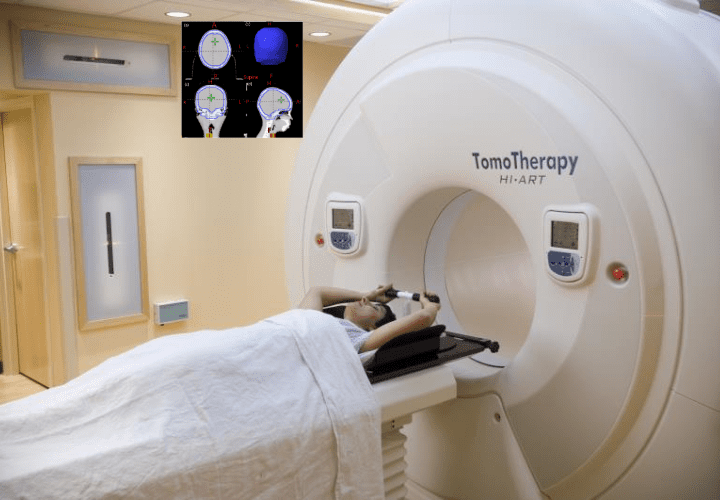Tomotherapy where precision and efficiency meet health

Tomotherapy where precision and efficiency meet health
- onco
- October 28, 2024
Have you ever stopped to consider the world’s most common cause of death? Well, nowadays, there are so many diseases through which people have died for no reason. However, cancer remains the world’s most significant cause of death, accounting for around 10 million fatalities per year. With millions of cases reported annually, cancer comes in numerous forms. Yet, a beacon of hope for cancer treatment in Delhi emerges amidst this sobering statistic, i.e. Tomotherapy. This comprehensive guide will explore the principles of tomotherapy, its benefits, and its role in modern healthcare.
Understanding Tomotherapy –
Combining the words ‘Tomography’ and ‘Therapy’, ‘Tomotherapy’ refers to a more advanced type of Intensity-Modulated Radiation Therapy (IMRT). Using cutting-edge imaging and delivery methods, malignancies can be precisely targeted. This technique uses a helical (spiral) radiation delivery system to give continuous treatment while taking precise pictures of the surrounding tissues and tumours.
How Does It Operate?
Tomotherapy’s dual-function system is its fundamental component. It uses a highly concentrated radiation beam to target specific tumour volumes, as opposed to typical radiation therapy, which may treat a vast portion of the body. This is how it operates:
- Imaging: CT scans are performed on patients before treatment to obtain accurate anatomical images of the tumour and adjacent organs. The tumour’s precise position, size, and form can be ascertained using this imaging.
- Treatment Planning: Radiation oncologists use advanced software to build a treatment plan that considers the tumour’s size and how it interacts with healthy tissues. This strategy ensures the tumour receives the most radiation dose possible without endangering neighbouring organs.
- Delivery: Radiation is delivered by the tomotherapy equipment in a spiral pattern, which enables the radiation beam to be continuously adjusted as it revolves around the patient. High radiation doses can be given more quickly with this helical delivery than with traditional techniques.
- Monitoring: Throughout the course of therapy, the system continuously assesses the tumour’s location and modifies the radiation beam as needed to consider any movement brought on by the patient’s breathing or variations in the tumour’s size.
Advantages of Tomotherapy –
- Accurate Targeting:
Tomotherapy has many benefits, one of which is its precision. Conventional radiation treatments frequently subject healthy tissues to needless radiation, which may have unfavorable effects. This is especially helpful in treating tumours that are close to vital organs like the brain, lungs, or abdomen.
- Flexibility:
Radiation therapy’s efficacy may be impacted by a tumour’s size and form changes throughout treatment. The tomotherapy system has the ability to recalibrate in the event that a tumour shrinks or changes position, guaranteeing that the radiation dose is nonetheless administered precisely.
- Shorter Duration of Therapy:
Patients undergoing traditional radiation therapy may find the multiple daily sessions over several weeks to be quite stressful on their bodies and minds. However, using tomotherapy, the length of the treatment could be significantly reduced. Many patients can complete their treatment in fewer sessions because of its effective administration of high doses of radiation.
- Enhanced Comfort for Patients:
Tomotherapy’s accuracy also helps to increase patient comfort. Because the treatment is focused, many patients report less discomfort and side effects. Patients frequently report improved quality of life both during and after treatment because they are exposed to less healthy tissues.
- Wide Range of Use:
Prostate, breast, lung, and brain cancers are just a few of the many malignancies that can be treated with tomotherapy due to its versatility. Because of its accuracy, it’s an excellent choice for cancers that are hard to treat with traditional radiation techniques. It is also appropriate for patients of all ages, making it a valuable cancer tool.
Tomotherapy in Practice – Selected Cases
Let us examine a few case studies demonstrating the efficacy of tomotherapy in treating various cancer types to provide more context for understanding its effects.
Case Study 1 – Cancer of the Prostate
Tomotherapy was chosen over traditional therapies by a 65-year-old man who had been diagnosed with localized prostate cancer because of its precision and lower side effects. As part of the treatment strategy, the prostate was the target of several tomotherapy sessions, with the bladder and rectum remaining unaffected. The patient had few adverse effects during treatment, and subsequent imaging revealed a considerable tumour shrinkage that spared the surrounding tissues. This instance demonstrates how tomotherapy can effectively cure cancer while maintaining the patient’s quality of life.
Read More Blog: Hormone Therapy For Prostate Cancer
Case Study 2 – Brain Tumor
In another case, tomotherapy was used to treat a 40-year-old woman who had been diagnosed with glioblastoma, a very severe form of brain cancer. Precise targeting was crucial because the tumour was close to critical brain structures. The tomotherapy technique minimized exposure to healthy brain tissue while enabling the delivery of high-dose radiation to the cancer. The patient experienced only mild side effects, and post-treatment imaging showed a considerable reduction in tumour size, allowing her to continue her high-quality lifestyle during therapy.
Read More Blog: Myths And Facts About Brain Tumors
Case Study 3 – Cancer in Children
When receiving cancer therapy, pediatric children can pose unique challenges. Tomotherapy was used to treat a 10-year-old child who had been diagnosed with neuroblastoma. The medical staff was able to modify the radiation regimen to target the tumour and safeguard his developing organs. The youngster experienced little discomfort at the end of his therapy, with no significant long-term adverse effects. This instance demonstrates how tomotherapy can be tailored to the needs of younger patients, offering a more secure and efficient course of treatment.
The Prospects for Tomotherapy –
Tomotherapy appears to have a bright future as long as technology keeps developing. Ongoing research further enhances its capabilities, including developing even more efficient radiation delivery technologies, incorporating artificial intelligence for more precise treatment planning, and better imaging tools. These developments could improve patient outcomes and increase the range of oncology uses for tomotherapy.
Regarding radiation therapy, tomotherapy is a vast advancement where efficiency and accuracy meet health. Tomotherapy is an effective way to treat cancer that not only improves treatment outcomes but also improves the patient experience by combining highly targeted drug administration with sophisticated imaging technologies. It is hoped that as we develop and enhance this ground-breaking method, more patients will gain from tomotherapy’s accuracy and adaptability, opening the door to a more promising future for cancer treatment.
Tomotherapy is a monument to what can be accomplished when compassion and technology come together to promote health and well-being in a world where every moment matters. Tomotherapy provides efficiency, hope, and, most crucially, the prospect of improved health outcomes for both patients and their families, whether they are dealing with a frightening diagnosis or a loved one undergoing treatment. It’s crucial to go over the advantages and disadvantages of tomotherapy with your medical team if you’re thinking about including it in your cancer treatment regimen. At Oncoplus, the finest cancer hospital in Delhi, we recognize the value of individualized treatment and use the newest technology, including tomotherapy, to guarantee the best results. Please contact us right now if you have any concerns or would like more information about tomotherapy; we look forward to working with you to get the greatest outcomes.





Leave a Reply